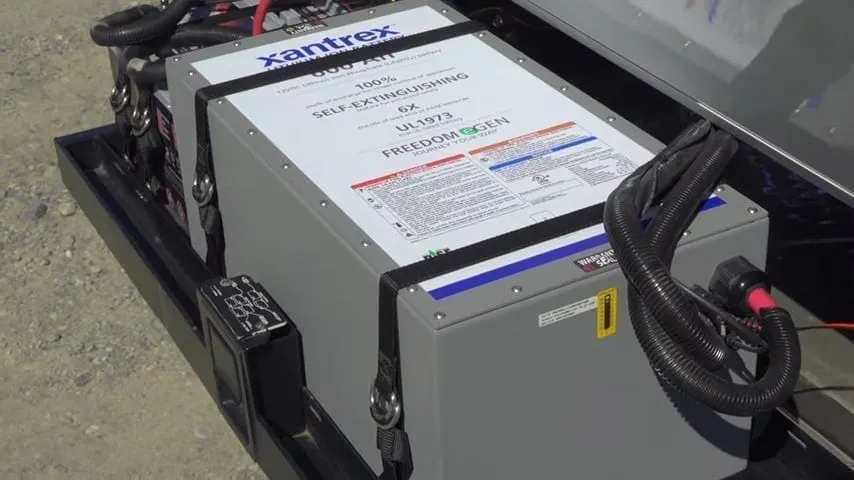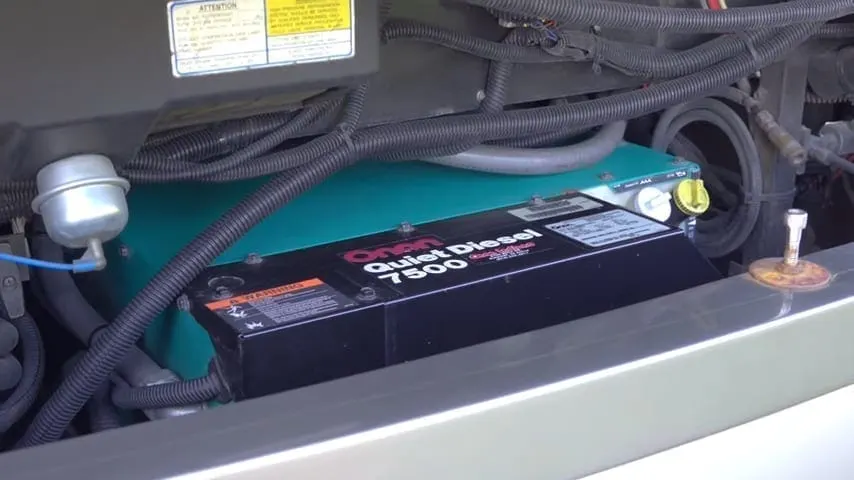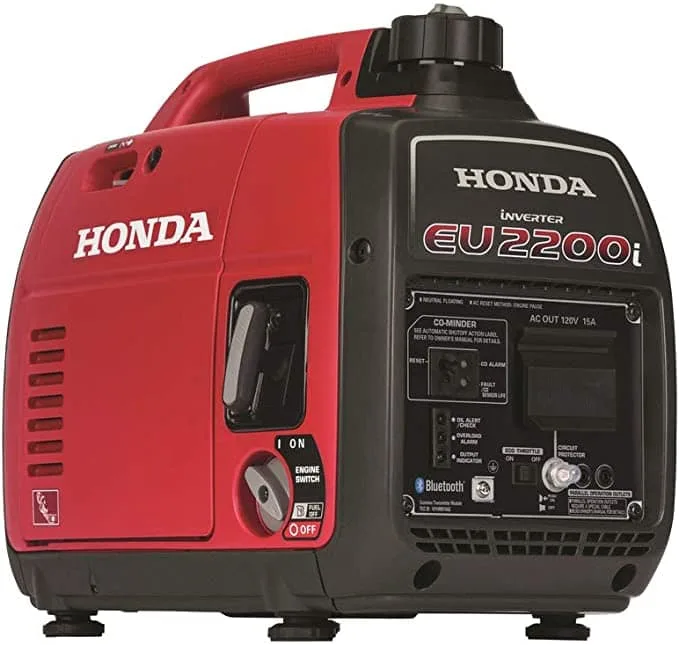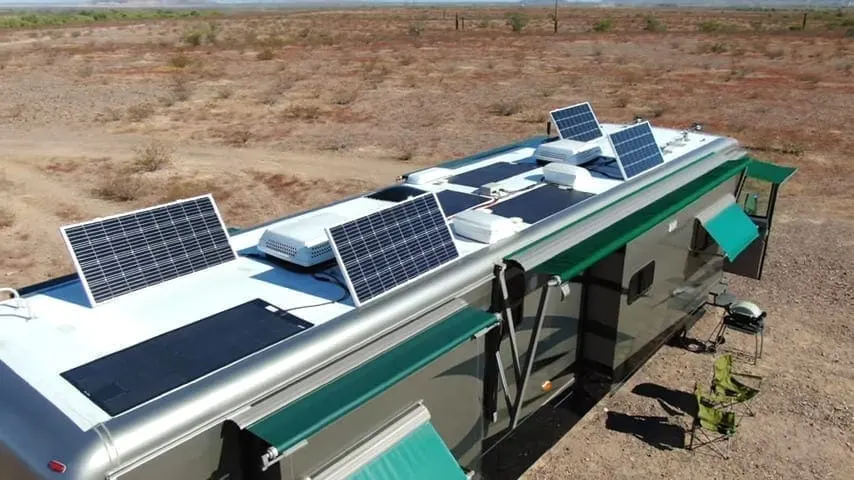When you first move into an RV or take it on an extended vacation, there can be an unexpected learning curve regarding how devices and appliances are powered. It’s important to understand how your RV house batteries work. Questions like “What does the RV battery actually power?” or “Do RV batteries charge when plugged into shore power?” are reasonable questions to ask. Today we’re taking a look at these questions and more in hopes of demystifying them a bit.
Do RV Batteries Charge When Plugged into Shore Power?
Your house batteries do indeed charge when plugged into shore power. House batteries are the ones that power your 12-volt accessories… interior lights, water pump, vent fans, etc. They can also power 120V AC appliances… IF your rig is equipped with an inverter.
If you have a motorized RV (class A, B, or C), plugging into shore power may or may not charge your chassis battery. That’s the one that starts the engine, and powers headlights, taillights, windshield wipers, horn, and other driving-related equipment. Many RVs do charge chassis batteries, but not all.
If your rig’s chassis battery (or batteries, in larger motorhomes) aren’t charged by shore power, which is more common in smaller rigs, they’ll only be charged by the alternator when the engine is running.
Before you plug into the nearest shore power outlet, it’s crucial to protect your RV’s electrical system! In our last post, we talked about RV power cords and included more information about protecting your rig from “bad” shore power. You can check that out, or look into the Hughes products we use to protect our RV.
Make sure your RV is protected from low voltage, bad RV park wiring AND power surges when connecting to shore power with a Power Watchdog and/or Hughes Autoformer. We never hookup without ours (we...Show More
Make sure your RV is protected from low voltage, bad RV park wiring AND power surges when connecting to shore power with a Power Watchdog and/or Hughes Autoformer. We never hookup without ours (we have both), and know our RV's electrical system and all our electronics are being protected.
Watch our Hughes Autoformer video
Watch our Hughes Power Watchdog video
Save 10% on your entire purchase when ordering from Hughes!
Show LessUnderstanding the RV Electrical System
Understanding your rig’s electrical system isn’t overly complicated, but if you’re not used to how it works, it can seem a bit daunting. In essence, most RV appliances run off one of two simple power sources: 12-Volt direct current (12V DC) or 120-Volt alternating current (120V AC).
12V DC Power

An RV’s house battery bank provides power to your 12V DC devices. It can also power 120V AC appliances and outlets… IF you have an inverter.
Your RV’s 12V house battery bank directly powers anything that runs off 12V DC. Again, this includes the water pump, interior lights, and vent fans.
Even if your battery bank consists of 6V batteries, they’ll be wired together in pairs to produce 12 volts. Some RVs actually run 24V systems, but that’s rare enough that it’s unlikely your rig will be equipped that way.
Your house batteries store & provide power whether or not you’re plugged into shore power, making it simple to run many of the devices you use daily. However, it’s important to note that your 12V DC system probably can’t power all of your appliances (think air conditioning for example) and also has limits on storage capacity depending on the number, size, and type of batteries you have.
This is why it’s so beneficial to be able to recharge your house batteries with access to shore power, a generator, solar power, or while driving.
120V AC Power
The 120V AC system operates the more power-hungry appliances. Your microwave oven, air conditioner(s), and 120V household power outlets all work from this system.

A generator is another way to charge your house batteries and also to power 120V AC appliances and outlets throughout your RV.
120V AC power in an RV is available from one of three sources: Shore power, generator power, or an inverter.
The easiest option for powering the 120V AC system is plugging into shore power. Your rig will typically have either a 30-amp or 50-amp plug that connects to a corresponding outlet, although the smallest RVs might be equipped with a 15-amp plug, just like a typical household appliance.
If you don’t have access to shore power, all is not lost. Many RVs have an onboard generator, which can power your 120V AC system when you’re boondocking or are otherwise away from a power pedestal. You can also purchase a portable, stand-alone generator if your rig lacks an onboard generator.
How is the RV Battery Charged on Shore Power?
When you plug your rig into shore power, the battery charges via a device called a converter, which converts AC power into DC power so that your battery charges correctly.
You can also charge your house batteries with an appropriate 12V battery charger that’s applied externally. But most RVs have a built-in converter (also typically known as a converter-charger). Larger RVs, which often come equipped with inverters (which produce 120V AC from your 12V DC battery bank), frequently combine all of these features into one unit, known as an inverter-charger. We’ll leave the detailed dive into that device for another day!
RV Converter / Converter-Charger
Your RV’s converter is a multitasker. When plugged into shore power, it feeds power to your appliances AND charges your house batteries.
Now not all RVs are wired the same way, but the basics are the same. Typically, the converter is part of the power center, which is where the 120V AC breakers and the 12V DC fuses/breakers are located. This is what allows the differing power systems to send the appropriate current to the right appliances: 12V power is sent to the DC devices, and 120V power to the AC ones.
The converter also acts as a charger, sending 12V DC power to your house batteries, allowing them to charge up whenever you’re connected to shore power. Most RVs today will come with a converter/charger that provides a balanced, 3-stage charging profile in order to recharge your battery(ies) properly so that you can get the most life out of them.
Other Ways to Charge Your RV Batteries
As previously mentioned, in addition to plugging into shore power there are multiple ways to charge your RV’s house batteries.
With a Generator

Honda portable generators like this one (available on Amazon) are a popular choice.
Motorhomes frequently have an onboard generator that’s wired to an on-off switch inside your rig’s cabin. Your generator provides 120V power to your electrical appliances, including your onboard converter/charger. With the generator running, the converter/charger replenishes the power in your house batteries, just like shore power would.
If your RV doesn’t have a built-in generator, you can get any number of small, portable generators that you can plug your RV into. Effectively, it’s like plugging into shore power… except you’re limited to the output capacity of the generator, so you’ll be limited in what you can run. Regardless, it’s plenty of power to charge your batteries.
With either situation (onboard or portable generator), be aware that when you supply 120V power to the RV, the onboard charger will most likely start charging your battery(ies) right away (or after a few minutes of “thinking”), replenishing the power you’ve used. It’s good to be aware of this fact so that you don’t accidentally overload your generator: don’t turn on too many high power-draw appliances until you’re sure the generator can handle it (or until the charger has gotten closer to finishing it’s charging cycle)
Through the Alternator
Many motorhomes are wired so that the engine’s alternator charges both your vehicle (chassis) battery and your RV (house) batteries when you’re driving down the road. There are two common systems that RV manufacturers use: a BiRD (Bi-directional Relay Delay) or an echo charger.
- A BiRD system uses a high-capacity relay to link the chassis & house batteries together, allowing the house battery to charge off the alternator when the engine is running (and vice versa when plugged into shore power).
- An echo charger takes a portion of the charging current from the chassis battery (once it nears being fully charged) and supplies it to the house battery bank, and can be installed after-the-fact if your RV didn’t come with one (like this unit from Xantrex, available on Amazon).
Either system is convenient, especially if you move around a lot. Just be aware that your RV may not be wired this way… it may only charge the chassis battery when the engine is running, not both battery banks.

RV solar panels are a fantastic way to harness the power of the sun to deliver energy to your RV’s batteries.
With Solar Power
Solar power is another commonly chosen option for charging RV batteries. While most RVs don’t come off the lot with pre-installed solar panels (or at least not enough solar for spending any reasonable time off the grid), it’s become a wildly popular add-on for many RVers, including us!
Solar is a game-changer for camping off the grid. With our (admittedly large) system, we can function virtually as if we were plugged into shore power (as long as there’s sun), without having to run our generator to do it. With a residential refrigerator (power hog), that’s pretty impressive.
You can either add permanently-mounted solar panels to your RV’s roof or opt for portable solar panels that you place in the sun.
Use a Battery Monitor to Prevent Draining Your Batteries Too Far
Some RVs come with a battery monitor; most don’t. This monitor (and we’re not talking about the “idiot lights” that show your battery status in 25% increments), however, can be a critical piece of equipment, whether you have a single house battery or a bank of multiple batteries.
The reason you want to monitor your batteries (especially flooded lead-acid batteries) is that you don’t want to drain them too low. Lead-acid batteries can be seriously damaged if you use more than 50% of their rated capacity, dramatically reducing their useful lifespan. This isn’t the case with lithium batteries which can be drawn down much further without issue.
- Read your battery bank like a fuel gauge
- Package Dimensions: 12.065 H x 16.764 L x 9.652 W (centimeters)
A battery monitor does just what the name implies: it monitors your battery, giving you insight into the amount of power that remains so you can avoid draining them too far (and know that you have enough power to get you through the night).
Conclusion
There are many variables to understanding your RV’s electrical system. “Do RV batteries charge when plugged into shore power?” is just one of many power-related questions every RVer should be able to answer. We hope running through some of the basics here has offered you a helpful start to understanding a bit more about your RV’s electrical system.
And, in case you missed it (or skipped to the end)… the answer to the question “Do RV batteries charge when plugged into shore power?” is YES! ????
Geek Out with Us Every Week
Join our newsletter to learn about all things RV-related. Every week we offer free tips, tricks, product reviews, and more to our online community of RVers. Whether this is your first time on the road or you’re a seasoned expert, we’d love for you to geek out with us!




Mike G
Wednesday 27th of September 2023
I have a Northstar 8.5 Arrow Truck Camper. I've always just used one 12v battery. Last yr battery kept dying and setting off low battery alarm on my carbon monoxide detector. Time to buy a new lead acid battery. My question is: I have 2 black leads and 2 white leads coming from the camper. For the last 10 yrs, I've always wired 2 blacks to pos, and 2 whites to Neg. NOW, I want to use ( 2 ) lead acid batteries. I can't understand why I have 2 leads coming from my camper into the battery box area. Any suggestions on how to wire?
TheRVgeeks
Wednesday 27th of September 2023
Hi Mike. Likely, the two sets of wires are some combination of power in & out, or from the different supplies (one from the umbilical to the truck, one from the converter/charger)... or something like that. It would take some sleuthing, tracing the sets of wires, to know 100% for sure.
If you're just going to add a second 12V battery, to double your RV's amp-hour capacity... you'd want to wire the two batteries in parallel (positive-to-positive and negative to negative), like this:
Be sure to notice that the leads that connect to the RV are connected across the batteries... meaning that the black cables connect to the positive terminal of one of the batteries, while the white cables would be connected to the negative terminal of the other battery. This makes sure that the power flows evenly across both batteries.
If, however, you wanted to switch to using 2 x 6V batteries (which are better at handling deeper charge/discharge cycles and, in the same size, typically have higher amp-hour capacity), you'd need to wire the two batteries to each other in series (positive-to-negative), instead. That would look like this:
Again, notice that the load cables (to/from the RV) are attached to terminals on different batteries. If you want to understand the difference between the wiring styles, check out this article: RV Batteries In Series vs Parallel: Wire Them Correctly
And for some more info on deep cycle batteries for RVs, check out this article: What Makes Deep Cycle RV Batteries Different?
Hope this helps!
Donny McGlasson
Sunday 24th of September 2023
Big fan. I'm 2nd owner of 01 MADP4095 & I've benefited a lot from your videos. Thanks so much. Question. about 3 years ago I replaced old freedom20 with xantrex freedomxc2000. recently during power outage at our park in Rockport, TX we didn't notice power was out and drained ALL our batteries. When not connected to external power aren't the batteries (house & chassis) supposed to separate to prevent this? Thanks, Donny
TheRVgeeks
Monday 25th of September 2023
Hi Donny. Yikes. Yes... normally, the two battery banks should be separated/isolated from one another to ensure that neither is over charged/drained. Newmar likely used the same system in your '01 as in our '05... a BiRD (Bi-Directional Relay Delay) that uses a large solenoid and small "brain" to connect the two battery banks together when charging (and to disconnect them if one drops too low, to prevent draining both). Sounds like that solenoid could be stuck/failed and/or the "brains" malfunctioning. You could check by monitoring the voltage on the house AND chassis battery banks when charging on shore power... and then when shore power is removed and a 12V load (or a 120V load through the inverter) is pulling the house batteries down.
When you first plug into shore power and the onboard charger kicks on, the house batteries should start charging first (with no charge going to the chassis batteries). Once the house batteries get close to full (don't recall the exact voltage for the BiRD to kick in), the solenoid should close and connect the two banks, so charging can flow to the chassis batteries.
When both sets of batteries are full and you disconnect from shore power, it's possible for the two banks to stay connected together for a time... allowing house loads to drain the chassis batteries some, until they drain down to another set point that should trigger the solenoid to disconnect. After that, only the house batteries should drain and the chassis batteries should remain at about 12.8V.
If that's NOT what happens... something's wrong with your BiRD (or equivalent system) and it likely needs repair/replacement.
Frank Vega
Tuesday 7th of February 2023
I understand now about how house batteries get charged, but my motorhome has a on/off knob that I guess turns on battery power to all the lights, outlets, etc., when coach is not on. So with that said, should that knob be ON when connected to shore power? Not sure and there is no mention of this? Because, I believe that's why my generator won't start because of low battery. Thanks for any help. Also it is a new 2023 Thor 24' motorhome.
Adam
Monday 18th of September 2023
@TheRVgeeks, I have a similar question to Frank’s. I have a brand new 2023 Winnebago Vista and keep it plugged in to my home when I am not using it for travel (I live in Las Vegas, where it’s very very hot, so I have the air conditioning kicking in when it gets over 110 degrees in the coach). My batteries that came with the RV fried within 8 months. Am I over charging the batteries, causing them to burn up when I plugged into shore power when not using the RV for several month, plugged in all the time? Also, I just recently found the off switch that Frank talks about, and was curious if that will save the batteries while plugged in to shore power? Should I keep it turned to off for these extended shore power times? If not, what is the switch for? Thanks in advance!
TheRVgeeks
Tuesday 7th of February 2023
Frank… that on/off knob COULD be the shutoff for your RV’s chassis batteries (generators often start from the same batteries that start the coach’s engine). The important thing to check (all RV manufacturers do things a bit differently) is if, when plugged into shore power with the shutoff switch turned to the OFF position, do your RV’s batteries still get charged? Use a multimeter to see if their voltage stays up around 13+ volts. If they don’t, then the batteries may slowly drain while the switch is off… even though you’re plugged into shore power!
Henry Godot
Sunday 29th of January 2023
Understanding lead acid battery chemistry goes along way when it comes to taking good care of them. Bogart Engineering has a blog post explaining this in detail -http://www.bogartengineering.com/amp-hrs-based-charging-control.html
Jim Hudson
Thursday 22nd of September 2022
Thx. Good info.